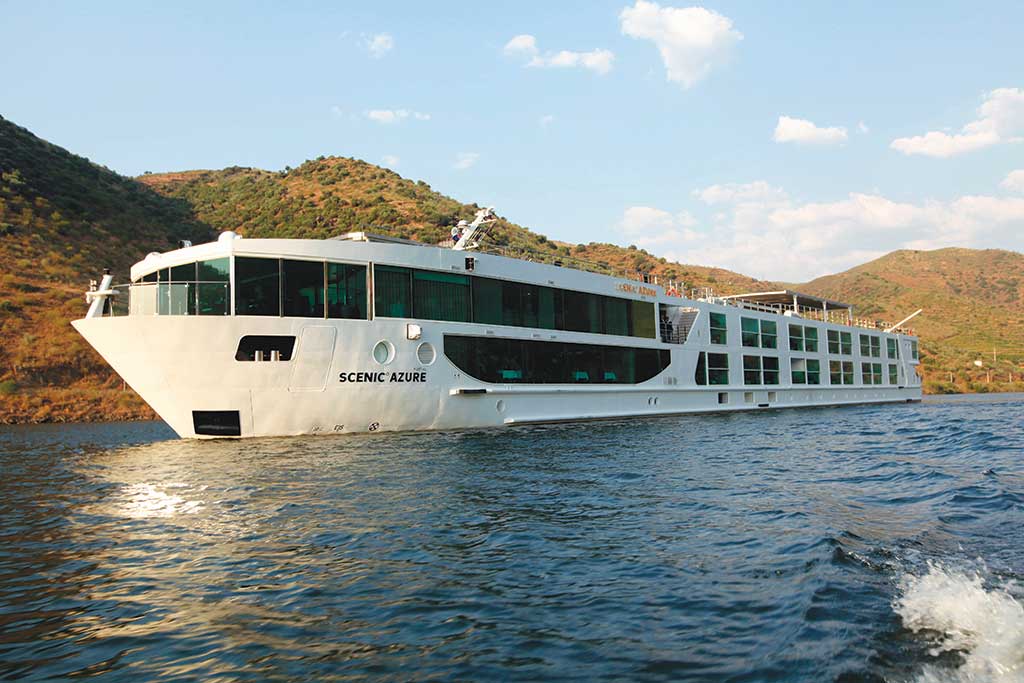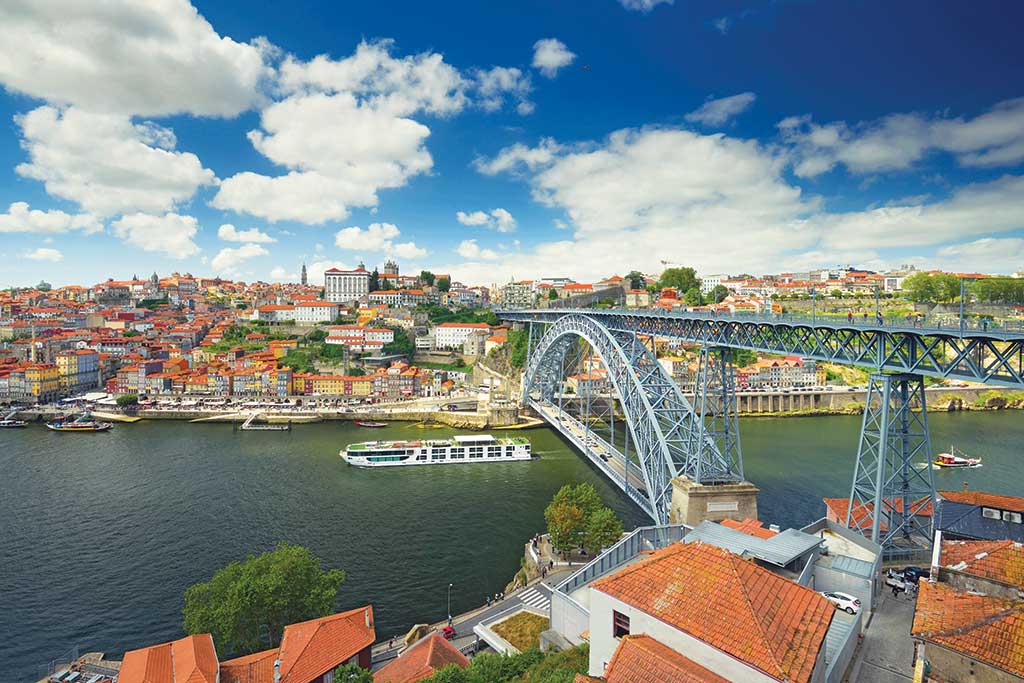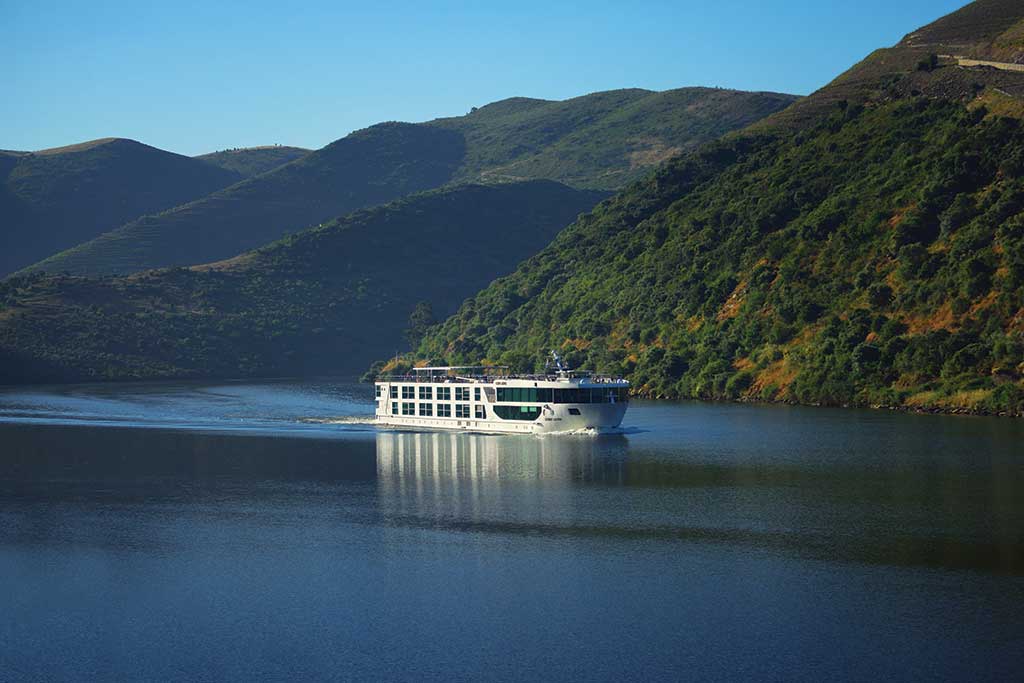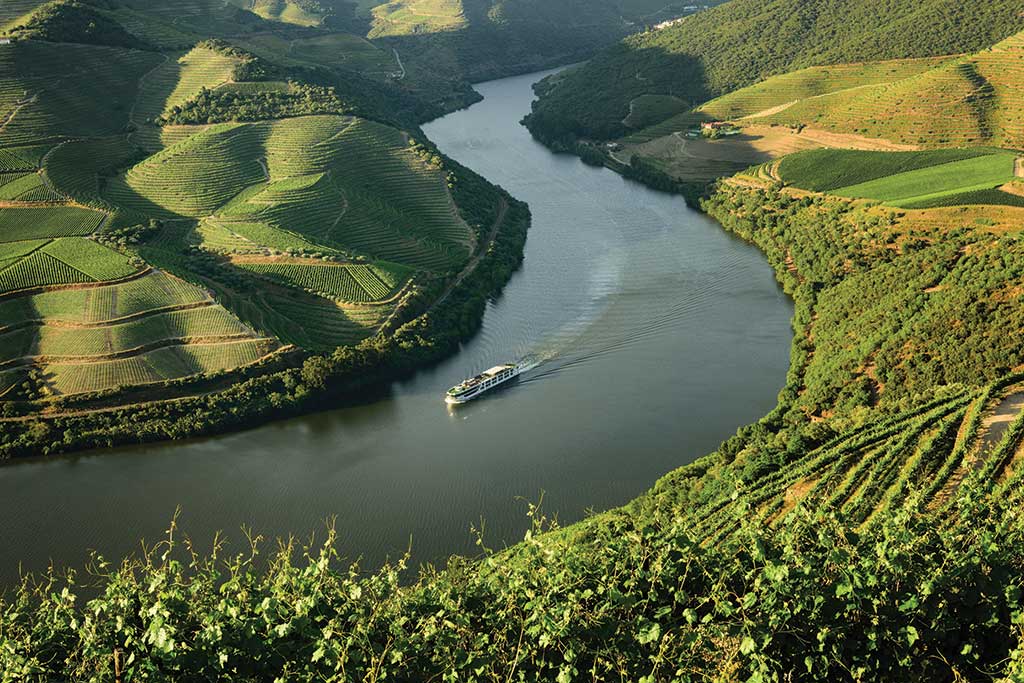The Scenic Azure offered much more than simply sitting in the sun thinking about wine and watching the vineyards float by. Each day there were two and sometimes three excursions from which to choose.
Two years ago, my partner Jaimie and I went on our first river trip, a romantic cruise on the Rhine and Moselle rivers with Scenic Cruises. We were enchanted floating down the river watching the world go by, or racing each other down a forest trail on the ship’s super-cool electric bikes. When we heard that the cruise line had launched a brandnew five-star ship and was offering a ten-night cruise on Portugal’s magnificent Douro River, we signed on.

The Scenic Azure
When we arrived at the ship, our butler showed us to our sunny cabin, one of 48 on the small, luxury Scenic Azure (www.scenicusa.com). We had a private balcony suite complete with floor-toceiling windows that, with a push of a button, slid open and turned into an open-air sun lounge which included a table for private dining alfresco. Both the head and foot of our queen-sized bed could be raised and lowered hydraulically, especially convenient for watching movies on TV. Both the L’Occitane amenities in the bathroom and complimentary beverage and snacks from the well-stocked minibar were replenished daily, a good thing because I covet Fritos.
On board was a massage room, a river-facing gym, and a spacious sundeck with a walking/running track, outdoor pool and Jacuzzi, sun loungers, and a shaded area for dining and lounging. Each night an onboard singer performed at the bar that conveniently stayed open until the last person left. Best of all, everything on the ship was complimentary including unlimited alcohol, beer, and fine local wines.
I love it when “all-included” means exactly that: complementary meals and wine in all the ship’s restaurants, 24-hour room service, tour guides, excursions, transportation (plushy coaches with leather reclining seats to catnap when heading back to the ship), and a hightech listening device that I was crazy about because we could walk away from the guide and still hear perfectly. All the factual and historical information is stored on the device. Even tips and gratuities are covered during the cruise, and the only extra charges were for a haircut or massage.
The sleek new Scenic Azure was docked on the other side of the Douro River in Gaia, opposite Porto. After we unpacked, we toured the ship, and then walked down the gangplank to the pier below where children kicked around a soccer ball and waved when we passed by. A few blocks away was Afurada, a quaint fishing village. On the dock sat a few fishermen mending their nets, and as we passed by, one of them smiled and said, “Bon Dia,” typical of the hospitality we would find everywhere. Past the dock were cobblestoned streets with houses side by side, each made of colored tiles, and above every doorway was a tile picturing a saint of protection. Porto’s tiles not only keep out the humidity but are very colorful because the city is built from gray rock. Even the railway station is made from 25,000 blue and white tiles.
Balancing loaves of bread in a basket on her head, an older woman walked past and gave us a toothless grin. Women on the street sold freshly caught sardines by weight. Three restaurants stood side by side, and, in each, sardines were being cooked on an outdoor grill.
Portugal has Europe’s highest fish consumption, especially cod (bacalhau), a staple since the 15th century. There are more than 365 ways to cook cod (grilled, boiled, fried, stewed, roasted, steamed, and more), one recipe for every day of the year: think salted cod fritters, cod casserole, baked cod, cod stew. Today, cod is still dried, salted, and soaked in water or milk, the same way they preserved it before refrigeration.

View From The Royal Suite
There were endless choices of food on board the ship. The breakfast buffet included complimentary Champagne, hot and cold dishes, cheeses, fruits, yogurt, and freshly baked bread and pastries. Lunch consisted of at least four choices of meat, fish, and vegetable dishes, assorted salads, cheese, and deliciously sinful desserts. The lounge was open 24/7 with an unlimited supply of homemade chocolate chip and oatmeal cookies, 12 different types of tea, and a coffee machine that made everything from macchiato and cappuccino to Irish coffee with Baileys.
Six dining options included a main dining room with oversized picture windows so you won’t miss any scenery; Table La Rive offered a French dégustation menu (think: gravlax, lobster medallions, and sirloin) paired with fine local wines. I rarely eat meat, but the ship offered the best steak I have ever eaten, and Jamie, a steak fanatic, agreed. The elegant Portobello’s had a six-course tasting menu and paired wines. In case anyone was hungry, an all-day café served snacks, pizzas, and desserts.
And then there was my favorite, the Portuguese buffet barbecue on the sun deck with barbecued meats and fish of every kind (including cod), and a multitude of salads. We dined and sipped local Portuguese wine while the boat floated down the scenic river. I loved sitting outside (or on our private sun deck), because when we passed a beach everyone would wave, and we waved back again and again. When we sailed deep into wine country, we sat mesmerized by the endless steep rows of contoured terraced vineyards on both sides of the bank.
For centuries, the Douro Valley has produced some of the world’s best port wine, which comes in dry, semi-dry, and white varieties. The early settlers understood the region was ideal for cultivating grapes, but the steep hills above the river made planting vines difficult. It took centuries before they carved vineyards along the contours of the hills and began to grow grapes. The fermented grapes were shipped back up the Douro River to Porto in flat-bottomed boats, because the depth of the river is only 12 feet. When the barrels arrived after a three-day journey, the wine was aged in warehouses along the river. Today, there are 60 wine cellars along that same river in Porto.
It might be a city visit to a magnificent Cathedral or a glittering palace followed by shopping for cork products, Portuguese tiles, and colorful pottery, including beautifully colored ceramic fish. It might be a drive to a village passing by olive and cork trees and almond and fruit orchards. One day Jamie stayed on board to hang out at the pool, and I went kayaking on the placid Sabor River followed by a picnic on the bank. Another day we visited a monastery to see how the 12th-century monks lived. It was hard to believe that the monastery was still standing.
One of our tours was to the Ducal Palace of Guimarães, dating back to medieval times and the seat of the first King of Portugal. That day, we also sailed to Regua and were treated to a private cocktail party that included tasting port wine varietals on the manicured
terrace of the Douro Museum. Another day, we visited the Mateus Palace, the historic icon depicted on the labels of Portugal’s famous Mateus rosé wine. We walked across Ucanha, Portugal’s first toll bridge above crystal-clear waters of the Varosa River, and we sailed as far as Salamanca on the border of Spain where we had a tapas lunch accompanied by a flamenco dance performance. After the show, the dancers dragged many of us on stage to participate with them, and from initial timidity, it turned into a raucous party.
My favorite excursion was to the postcard-perfect village of Provesende. When we walked into the village church, the organist played a private concert for us, so profoundly beautiful I had to wipe away tears. In Provesende, we also visited the village bakery where locals bring their unbaked dough, and the village oven bakes 80 loaves at a time. The village potter sat at his wheel outside the bakery, turning out perfect cups and bowls that he later fired and sold. On another street, there was a boutique selling hand-made linen and wool products, from which many passengers had to be coerced away for our next stop, the centuries-old restored family manor house of Morgadio da Calçada, where we were treated to their special vintage wines.
Our guide would constantly give us useful information and entertain us with trivia. For instance, Portugal emerged as an independent entity around 1140, but the Portuguese explorers in the Age of Discovery such as Henry the Navigator and Vasco da Gama wanted to outdo Italy’s achievements during the Renaissance. We also learned that port is swirled and tasted with the right hand only because that’s the sword hand, and using this hand would stop you from fighting.

Scenic Azure Passes Under The Dom Luís I Bridge in Porto
The stone walls we saw on excursion were originally built to fence in the cattle and they date back to the Celtics. And the reason why some churches have so many paintings is because a few centuries ago people couldn’t read, and the paintings were the only way to tell the stories.
I liked the miscellaneous facts we learned during the cruise, such as in the fifth century men didn’t need knives because when eating fish and meat, they used their daggers as cutting utensils, and at medieval banquets they ate with their fingers. A man’s dog would sit at his owner’s feet and became a living napkin when the men wiped their hands on the dog’s fur.
Once we visited a palace and looked at a bedroom in which the bed didn’t look long enough for a ten-year-old child. It turns out that in the 15th century, people slept sitting up to help digestion; some believed if they slept lying down, their souls would slip out.
Another afternoon while sailing, Jamie and I tried Portuguese lessons and, later, a tile-painting workshop. But no matter what we might be doing, I kept an eye on the ever-changing scenery, so lush and verdant that I couldn’t stop taking photos.
Just as fascinating as the information we were learning, was the Douro River itself. The 557-mile-long river is the third largest of the Iberian Peninsula. Between 1950 and the 1990s, five locks and dams were built, and in 2001, UNESCO declared the Douro River a World Heritage Site. We had the opportunity to go through all five locks during our voyage.
Going through a lock on the Douro is unlike going through a lock on a French barge, where there might be a difference in width of a few feet. The locks on the Douro are gigantic; Jamie and I would stand by the railing on either side of the boat and look down below. It felt as though we were standing at the top of an Olympic-sized high-dive board, and we wondered how we’d ever get through the lock. Could we really descend that far down? And what about the sides of the boat? The vessel seemed to have only an inch clearance on each side. Could it make it through? It succeeded every time because the Scenic Azure was purpose-built for the Douro, just wide enough to successfully maneuver through every lock, and flat-bottomed enough never to end up aground.

The Scenic Azure on the Douro River
Going through a lock was a marvel. As the ship entered the lock, the sky turned dark because we were hedged in by the lock’s huge blackened concrete walls. The water would gush as the huge steel doors opened, and the ship glided down to the level of the river below. Each time, it amazed me to see the maneuver perfectly achieved.
Our last night was not spent aboard the ship. We left the Scenic Azure and headed to Burmester Cellars, a wine cave, which dates back to 1780, that has been turned into a fine dining candle-lit restaurant. During dinner, we were entertained by a well-known Portuguese fado singer. Fado means destiny or fate, and while most songs are sad love songs, there are some happy tunes as well. One of the songs she sang translated as, “If we have bread, wine, lots of kisses, and two arms waiting to hold us, then we are happy.”
Here we were, Jamie and I, sitting in the romantic candlelight, dining on octopus carpaccio and Portuguese beef tornedo, sipping fine Burmester Douro wines and listening to fado love songs, a perfect ending for a perfect cruise.


